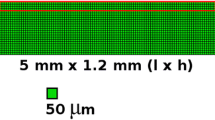Abstract
In recent years, the scientific and industrial relevance of additive layer manufacturing (ALM) has grown. In the metal area of ALM, the capacity of laser technologies is noticeably limited. This is mainly due to an inertial beam deflection device, which is also referred to as a mirror galvanometer. In contrast, the electron beam technology offers high power density as well as considerable scanning rates. Therefore, electron beam melting (EBM) seems to be suitable for processing a broad variety of alloys in an economic way. In particular, the enormous scanning rates which can be realized by use of an electron beam enable an economic manufacture of high quality parts. However, profound expertise is required in order to establish EBM as an industrial production technology. By means of mathematical–physical modelling, process stability of the melting step is being increased. Moreover, by solving a detailed thermal model using the finite element method (FEM), substantial knowledge of adequate parameter settings in dependence of the utilised material is developed. Finally, a process window as a function of scan speed and beam power is developed based on experimental results.








Similar content being viewed by others
References
Wohlers T (2007) Wohlers Report 2007. Wohlers Associates Inc., Fort Collins, Colorado
Lutzmann S, Kahnert M, Sigl M (2006) Elektronenstrahlsintern als Zukunftstechnologie im Rapid Tooling. Utz, München
Patent WO 1994026446 A1 Method and device for producing three-dimensional bodies (24 Nov 1994). Larson R Pr.: SE 9301647 (12 May 1993). Larson R.: method and device for producing three-dimensional bodies
ARCAM: APPLICATIONS (2007) http://www.arcam.com/ applications/index.asp: Accessed 18 June 2007
Taminger KMB, Hafley RA, Dicus DL (2002) An enabling technology for future space missions. In: Keicher D et al (eds) Proceedings of the 2002 international conference on metal powder deposition for rapid manufacturing, San Antonio (Texas, USA) 8–10 Apr 2002. Princeton (New Jersey, USA): Metal Powder Industries Federation 2002, pp 51–61
Davé VR (1995) Electron beam assisted materials fabrication. Dissertation, Massachusetts Institute of Technology
Qi HB, Yan YN, Lin F, He W, Zhang RJ (2006) Direct metal part forming of 316L stainless steel powder by electron beam selective melting. In: Proceedings of the institution of mechanical engineers—Part B—engineering manufacture 202 11, pp 1845–1853
Meindl M (2004) Beitrag zur Entwicklung generativer Fertigungsverfahren für das Rapid Manufacturing. Dissertation, Technische Universität München
Dobeneck D, Löwer T, Mehnhard C (2002) Entwicklungspotenziale der thermischen Materialbearbeitung mit Elektronenstrahlen im Vergleich zu Laserstrahlen. In: Sepold G et al (eds) Laserstrahlfügen : Prozesse, Systeme, Anwendungen, Trends; Beiträge zum 4. Laser-Anwenderforum Bremen; 12–13 Sep 2002. BIAS-Verlag, Bremen, pp 35–44
Schiller S, Heisig U, Panzer S (1977) Elektronenstrahltechnologie. Wissenschaftliche Verlagsgesellschaft, Stuttgart
Kahnert M, Lutzmann S, Zäh MF (2007) Layer formations in electron beam sintering. In: Bourell DL et al (eds) Solid freeform fabrication symposium proceedings 18, Austin (Texas, USA). The University of Texas at Austin
Gusarov A, Yadroitsev I, Bertrand P, Smurov I (2007) Heat transfer modelling and stability analysis of selective laser melting. Applied Surface Science 254:975–979
Zäh MF, Kahnert M (2009) The effect of scanning strategies on electron beam sintering. Production Engineering 3:217–224
Zäh MF (ed) (2006) Wirtschaftliche Fertigung mit Rapid-Technologien: Anwender-Leitfaden zur Auswahl geeigneter Verfahren. Hanser, München
Baehr HD, Stephan K (1998) Wärme- und Stoffübertragung. Springer, Berlin
Heinrich H (1973) Theoretische und experimentelle Untersuchungen zur Bestimmung der Intensitätsverteilung im Strahlungsfeld von Elektronenbeschleunigern und der Dosisverteilung in elektronenbestrahlten Material. Dissertation, Akademie der Wissenschaften
Wagner CA (2003) Untersuchungen zum selektiven Lasersintern von Metallen. Dissertation, RWTH Aachen
Schlünder EU, Tsotsas E (1998) Wärmeübertragung in Festbetten, durchmischten Schüttgütern und Wirbelschichten: 33 Tabellen. Thieme, Stuttgart
Wärmeatlas VDI (2002) Berechnungsblätter für den Wärmeübergang, 9th edn. Springer, Berlin (extended edition)
Sih S, Barlow JW (1995) Emissivity of powder beds. In: Marcus HL et al (eds) Solid freeform fabrication symposium proceedings, Austin (Texas, USA). Kluwer, Boston, pp 402–408
Groth C, Müller G (2002) Grundlagen: Basiswissen und Arbeitsbeispiele zur Finite-Elemente-Methode mit dem FE-Programm ANSYS(R) Rev. 5.5, 7th edn. Expert, Renningen
Böhmer R (1997) Methodik computergestützter Prozessmodellierung. Oldenbourg, München
Author information
Authors and Affiliations
Corresponding author
Rights and permissions
About this article
Cite this article
Zäh, M.F., Lutzmann, S. Modelling and simulation of electron beam melting. Prod. Eng. Res. Devel. 4, 15–23 (2010). https://doi.org/10.1007/s11740-009-0197-6
Received:
Accepted:
Published:
Issue Date:
DOI: https://doi.org/10.1007/s11740-009-0197-6




